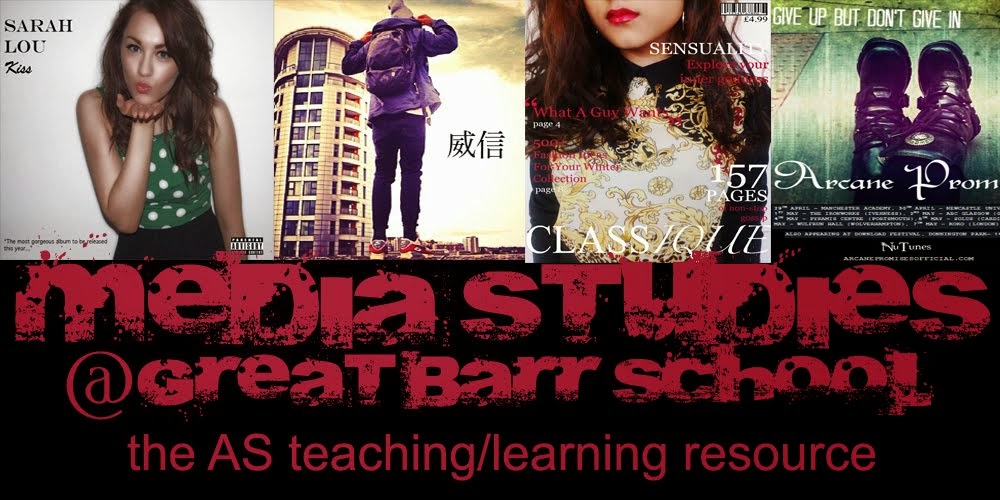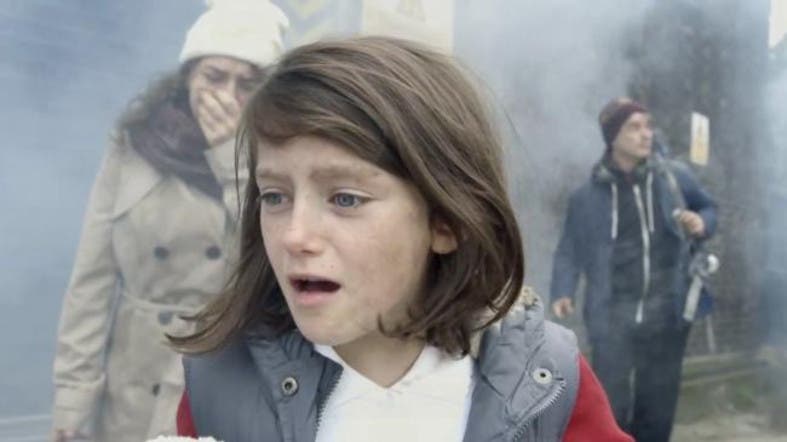media studies

student work 2012/14
Friday 29 April 2016
Thursday 28 April 2016
MEST1
Lets use this to explore issues of media forms and representations with a focus on institution and values
PHOTOSHOCK AGAIN
Today I thought we'd have a look at this article from the Daily Mail which touches on an issue we explored a few weeks ago - the whole use/abuse of Photoshop by magazines and celebrities.
Monday 25 April 2016
CONTROVERSIAL 2
Remember to start by considering the media mantra:
WHAT TYPE OF PRODUCT IS IT? [WHAT IS ITS INTENTION?]WHO IS IT AIMED AT? [AUDIENCE]
WHAT MIGHT BE THAT AUDIENCES EXPECTATIONS OF SUCH A PRODUCT?
DOES THIS PRODUCT MEET SUCH EXPECTATIONS - HOW? WHY NOT?
IS THE PRODUCT EFFECTIVE IN ITS INTENTIONS?
We're into controversial products once more - this time we have a focus on ideology, the whole intention and understanding element of media products.
Key here is a discussion of Hall - encoding/decoding and Mccomb agenda setting. you might also find Blumler and Katz apply here, too.

A television commercial for Dunkin’ Donuts, which was shown to the Taiwanese public, was pulled from the airwaves after being subject to considerable criticism from the American media. The ad showed a pale-skinned female eating a chocolate donut. After taking a couple of bites, the young girl’s face is suddenly painted to resemble a black person.
Human rights groups across America immediately labeled the advertisement racist, forcing the company to issue a strongly worded apology. However, ad creator Nadim Salhani – whose daughter was featured in the ad – was dumfounded by the reaction:
“It’s absolutely ridiculous… We’re not allowed to use black to promote our doughnuts? I don’t get it. What’s the big fuss? What if the product was white and I painted someone white, would that be racist?”

CON-TRO-VER-SY
Okay - its controversial advertising day! Below are a selection of adverts for you to practise your skills on. For each focus on: media forms analysis - the interaction of image and text - and then focus on audience and intention. Be certain to ask why these adverts decided to subvert audience expectations of the product type and consider which commercial techniques are being used.


In 2009 the popular fast food restaurant Burger King franchise located in Singapore decided to promote a new sandwich with tag lines "It'll blow your mind away" and a picture of a blonde woman with red lipstick about to bite into a 7-inch long burger.
The advert immediately provoked complaints with most seeing the interpretation / allusion that this advertisement blatantly uses sex to sell their product. Demeaning and filled with sexual imagery, the picture already speaks for itself. The young woman was seen as created to look like a doll. The copy used the words "blow" to strengthen the sexualised interpretation. The small print at the lower right corner states, "Fill your desire for something long, juicy, and flamed grilled...yearn for more after you taste the mind blowing burger"
Some years later, the model posted her response to the use of her face in such a campaign.
BURGER KING 'MODEL' RESPONDS TO ADVERT



Friday 22 April 2016
COURSEWORK COMPLIANCE
For those struggling with compliance, i attach the link to the Brief specifications. It is your responsibility to check that you have met all of these.
AS mest2-2016-coursework-briefs
Thursday 21 April 2016
LESSON 129016: HATERS
With the examination fast approaching, we need to move ever forward in the way that we explore media products. This time we're switching from the ideological obviousness of Save the children back into the commercial world. specifically sports advertising and the 2015 ADIDAS campaign with the catchy title 'There Will Be Haters'. The campaign features a selection of football superstars - Messi, Bale Rodriguez and Suarez - with a voice-over listing all of the put-downs, criticisms and hostile comments that they have [supposedly] had to face. The images are used to illustrate the narration.
Remember to start by considering the media mantra:
WHAT TYPE OF PRODUCT IS IT? [WHAT IS ITS INTENTION?]WHO IS IT AIMED AT? [AUDIENCE]
WHAT MIGHT BE THAT AUDIENCES EXPECTATIONS OF SUCH A PRODUCT?
DOES THIS PRODUCT MEET SUCH EXPECTATIONS - HOW? WHY NOT?
IS THE PRODUCT EFFECTIVE IN ITS INTENTIONS?
Before tackling the tasks it is useful to consider the words of John Fiske as a means of ensuring that we move beyond the simplistic listing of things we see in the advert and start to consider wider media and social issues of the impact of media products.
‘our society teaches
men that their masculinity depends upon successful performance’ (Fiske, 2010)
In what way does this product support such a viewpoint?
- Media forms
- How are media forms used to construct the life of celebrity footballers?
- Media Representation
- How is the brand identity of ADIDAS represented and conveyed in this advert?
- Media Audiences
- Why do you think that the advert attracted over 20.000.000 hits on the Adididas football TV channel?
- Media Ideologies
- What messages do you think are conveyed by the advert to audiences?
How might this product be compared in terms of lifestyle and the representation of celebrity footballers?
Friday 15 April 2016

For our analysis today we're going to explore a campaign advert - something that we've not spent too much time on thus far and products that can produce some interesting ideas.
Campaigning adverts are those produced by pressure groups and charities or even government departments with the aim of drawing attention to an issue, raising funds or provoking action [eg. giving blood; not driving and texting]
those that create and run such campaigns often say that campaign adverts often have to work harder than those that are commercially selling us a product or service. Why might this be?
WHAT TYPE OF PRODUCT IS IT? [WHAT IS ITS INTENTION?]
WHO IS IT AIMED AT? [AUDIENCE]
WHAT MIGHT BE THAT AUDIENCES EXPECTATIONS OF SUCH A PRODUCT?
DOES THIS PRODUCT MEET SUCH EXPECTATIONS - HOW? WHY NOT?
IS THE PRODUCT EFFECTIVE IN ITS INTENTIONS?
Released on March 5th 2014 the 90 second campaign video was launched in the run-up to the three year anniversary of the Syrian civil War conflict. Titled the Most Shocking Second a Day the film was made by DON'T PANIC for Save the Children UK. the film focuses on the fact that to date 10,000 children have lost their lives and 2.3 million people have become refugees from the conflict.
It closes with the words: "Just because it isn't happening here, doesn't mean it isn't happening."
"We hope the video will resonate with members of the public, particularly those who don’t know much about the situation in Syria so they can really understand the plight of innocent Syrian children. said Jake Lundi, Director of Brand and Communications at Save The Children. "The message to the public is just because it’s not happening here, doesn’t mean it’s not happening."
Jack Lundie, director of Brand and Communications at Save the Children, said the video was meant draw in members of the British public who are not familiar with the situation in Syria.
“We hope the video will resonate with members of the public, particularly those who don’t know much about the situation in Syria so they can really understand the plight of innocent Syrian children,” he said.
“It’s easy to forget that Syria was a middle income country, where children enjoyed the benefits of education, healthcare and the other basic rights our children take for granted—not to mention Facebook accounts, video games and youth culture.”
International media have responded to the advert positively, with the Independent calling it “sobering” and Adweek labeling it “brutally powerful.”
The video acquired more than 23 million views on YouTube in less than a week. The video was also listed as the first of five highly successful nonprofit branded videos in the first quarter of 2014.
In November 2014, American actor Ashton Kutcher posted an article about the video on his Facebook page and made it the second most-viewed brand video of the week on YouTube.[
As of April 2015, the video has accumulated over 46 million views on YouTube. According to Don't Panic London's website, the video was featured twice on the Reddit front page, was shared 920,000 times, and caused Save the Children's YouTube channel subscriptions to increase by over 1000%
MEDIA FORMS:
How are media forms used to convey the changing life of this young girl?
MEDIA AUDIENCE
What factors do you think lead to the video attracting more than 23 million You Tube hits in its first week of release and 46 million views in its first year?
MEDIA REPRESENTATION
How does the advert represent the life of a refugee?
MEDIA IDEOLOGIES
How effective is the product in using commercial marketing techniques in communicating its message to the audience?
The ad was released on 5 March 2014. It received news coverage immediately in many UK newspapers and magazines including the The Independent, Telegraph, Huffington Post (UK), Express, Metro, and The Mirror. It was also covered in Time Magazine, Adweek,Al Arabiya,and the Washington Post.[ The coverage in the Washington Post noted that the video would only seem shocking to people who had not experienced or read closely about the lived experiences of people who had gone through civil wars, and highlighted the newspaper's profiles of refugees from civil wars.
The video acquired more than 23 million views on YouTube in less than a week.[18] The reasons for its virality were dissected by a number of commentators, including Fairsay[19] and The Drum.[5] The following factors were identified: strong emotions, a video title ("Most Shocking Second a Day") that created what Upworthy has called a "curiosity gap" by providing just enough information to make people click to want to know more, and a smart initial paid promotion and publicity in the right circles.[19] The video was also listed as the first of five highly successful nonprofit branded videos in the first quarter of 2014.[8][20]
In November 2014, American actor Ashton Kutcher posted an A Plus article about the video on his Facebook page (A Plus is a website co-founded by Kutcher, who is also Chairman of the Board).[11][21] This resulted in 10 million page views of the video and made it the second most-viewed brand video of the week on YouTube.[22]
As of April 2015, the video has accumulated over 46 million views on YouTube.[1] According to Don't Panic London's website, the video was featured twice on the Reddit front page, was shared 920,000 times, and caused Save the Children's YouTube channel subscriptions to increase by over 1000%.[4]
LESSON 128516: MEDIA VIOLENCE

We now need to put in some practice time on applying our newly acquired knowledge of audience and the effects debate to see if we have understood what we have explored. Remember the examination is all about KNOWLEDGE AND UNDERSTANDING. Understanding is the application of knowledge. The first step is to analyse this image in terms of what we already know - mise-en-scene and representations. Click on the link belwo to go to the worksheet page of the blog and complete the tasks.
DISARMING BRITAIN WORKSHEET
Review the product viewed this far:
We will now explore a product that makes use of similar ideas but for a different purpose:
TASK A: MEDIA FORMS:
Let's first have a look at the language. What media forms are working here - what is the intended impact/effect?
What is represented in this product?
How is it represented?
why was it represented this way [intention]
what was the outcome?
Why was it received this way?
what is yoour opinion?
TASK B: MEDIA IDEOLOGIES
A key element of any media product is its ideology - the values that it is perceived to contain and transmit to its intended audience. an issue is often when the inmtention is mis-read or when it is viewed by those who it was not intended for.
Subscribe to:
Posts (Atom)


